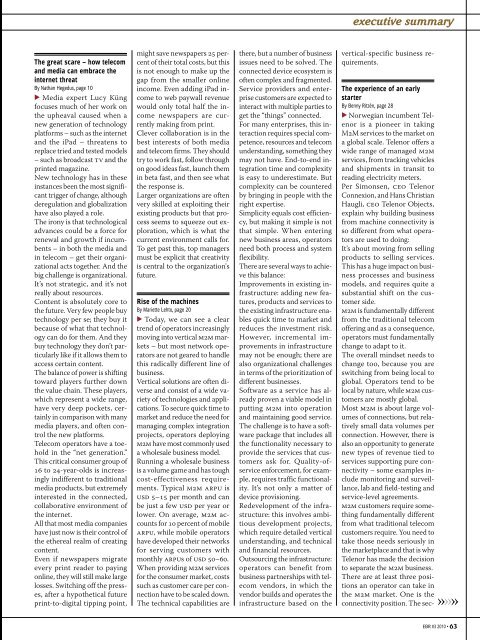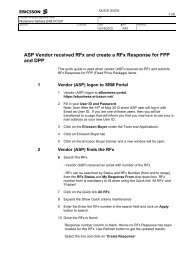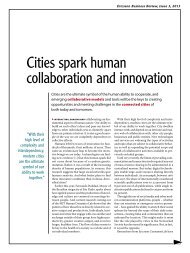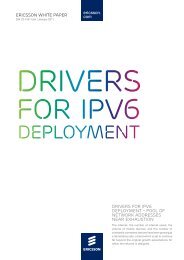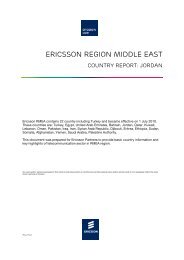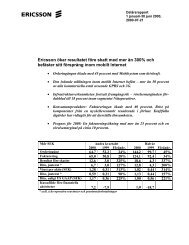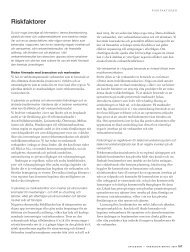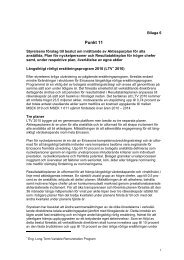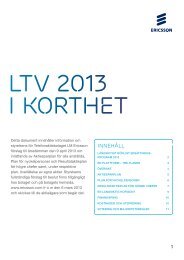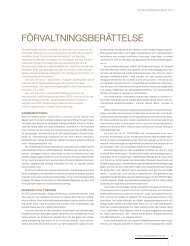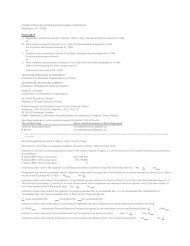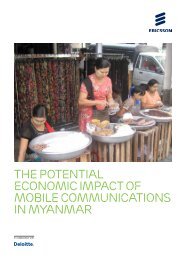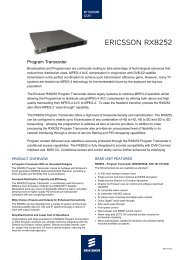Telenor's - Ericsson
Telenor's - Ericsson
Telenor's - Ericsson
- TAGS
- ericsson
- www.ericsson.com
You also want an ePaper? Increase the reach of your titles
YUMPU automatically turns print PDFs into web optimized ePapers that Google loves.
The great scare – how telecom<br />
and media can embrace the<br />
internet threat<br />
By Nathan Hegedus, page 10<br />
▶ Media expert Lucy Küng<br />
focuses much of her work on<br />
the upheaval caused when a<br />
new generation of technology<br />
platforms – such as the internet<br />
and the iPad – threatens to<br />
replace tried and tested models<br />
– such as broadcast tv and the<br />
printed magazine.<br />
New technology has in these<br />
instances been the most significant<br />
trigger of change, although<br />
deregulation and globalization<br />
have also played a role.<br />
The irony is that technological<br />
advances could be a force for<br />
renewal and growth if incumbents<br />
– in both the media and<br />
in telecom – get their organizational<br />
acts together. And the<br />
big challenge is organizational.<br />
It’s not strategic, and it’s not<br />
really about resources.<br />
Content is absolutely core to<br />
the future. Very few people buy<br />
technology per se; they buy it<br />
because of what that technology<br />
can do for them. And they<br />
buy technology they don’t particularly<br />
like if it allows them to<br />
access certain content.<br />
The balance of power is shifting<br />
toward players further down<br />
the value chain. These players,<br />
which represent a wide range,<br />
have very deep pockets, certainly<br />
in comparison with many<br />
media players, and often control<br />
the new platforms.<br />
Telecom operators have a toehold<br />
in the “net generation.”<br />
This critical consumer group of<br />
16 to 24-year-olds is increasingly<br />
indifferent to traditional<br />
media products, but extremely<br />
interested in the connected,<br />
collaborative environment of<br />
the internet.<br />
All that most media companies<br />
have just now is their control of<br />
the ethereal realm of creating<br />
content.<br />
Even if newspapers migrate<br />
every print reader to paying<br />
online, they will still make large<br />
losses. Switching off the presses,<br />
after a hypothetical future<br />
print-to-digital tipping point,<br />
might save newspapers 25 percent<br />
of their total costs, but this<br />
is not enough to make up the<br />
gap from the smaller online<br />
income. Even adding iPad income<br />
to web paywall revenue<br />
would only total half the income<br />
newspapers are currently<br />
making from print.<br />
Clever collaboration is in the<br />
best interests of both media<br />
and telecom firms. They should<br />
try to work fast, follow through<br />
on good ideas fast, launch them<br />
in beta fast, and then see what<br />
the response is.<br />
Larger organizations are often<br />
very skilled at exploiting their<br />
existing products but that process<br />
seems to squeeze out exploration,<br />
which is what the<br />
current environment calls for.<br />
To get past this, top managers<br />
must be explicit that creativity<br />
is central to the organization's<br />
future.<br />
Rise of the machines<br />
By Mariette Lehto, page 20<br />
▶ Today, we can see a clear<br />
trend of operators increasingly<br />
moving into vertical m2m markets<br />
– but most network operators<br />
are not geared to handle<br />
this radically different line of<br />
business.<br />
Vertical solutions are often diverse<br />
and consist of a wide variety<br />
of technologies and applications.<br />
To secure quick time to<br />
market and reduce the need for<br />
managing complex integration<br />
projects, operators deploying<br />
m2m have most commonly used<br />
a wholesale business model.<br />
Running a wholesale business<br />
is a volume game and has tough<br />
cost-effectiveness requirements.<br />
Typical m2m arpu is<br />
usd 5–15 per month and can<br />
be just a few usd per year or<br />
lower. On average, m2m accounts<br />
for 10 percent of mobile<br />
arpu, while mobile operators<br />
have developed their networks<br />
for serving customers with<br />
monthly arpus of usd 50–60.<br />
When providing m2m services<br />
for the consumer market, costs<br />
such as customer care per connection<br />
have to be scaled down.<br />
The technical capabilities are<br />
there, but a number of business<br />
issues need to be solved. The<br />
connected device ecosystem is<br />
often complex and fragmented.<br />
Service providers and enterprise<br />
customers are expected to<br />
interact with multiple parties to<br />
get the “things” connected.<br />
For many enterprises, this interaction<br />
requires special competence,<br />
resources and telecom<br />
understanding, something they<br />
may not have. End-to-end integration<br />
time and complexity<br />
is easy to underestimate. But<br />
complexity can be countered<br />
by bringing in people with the<br />
right expertise.<br />
Simplicity equals cost efficiency,<br />
but making it simple is not<br />
that simple. When entering<br />
new business areas, operators<br />
need both process and system<br />
flexibility.<br />
There are several ways to achieve<br />
this balance:<br />
Improvements in existing infrastructure:<br />
adding new features,<br />
products and services to<br />
the existing infrastructure enables<br />
quick time to market and<br />
reduces the investment risk.<br />
However, incremental improvements<br />
in infrastructure<br />
may not be enough; there are<br />
also organizational challenges<br />
in terms of the prioritization of<br />
different businesses.<br />
Software as a service has already<br />
proven a viable model in<br />
putting m2m into operation<br />
and maintaining good service.<br />
The challenge is to have a software<br />
package that includes all<br />
the functionality necessary to<br />
provide the services that customers<br />
ask for. Quality-ofservice<br />
enforcement, for example,<br />
requires traffic functionality.<br />
It’s not only a matter of<br />
device provisioning.<br />
Redevelopment of the infrastructure:<br />
this involves ambitious<br />
development projects,<br />
which require detailed vertical<br />
understanding, and technical<br />
and financial resources.<br />
Outsourcing the infrastructure:<br />
operators can benefit from<br />
business partnerships with telecom<br />
vendors, in which the<br />
vendor builds and operates the<br />
infrastructure based on the<br />
executive summary<br />
vertical-specific business requirements.<br />
The experience of an early<br />
starter<br />
By Benny Ritzén, page 28<br />
▶ Norwegian incumbent Telenor<br />
is a pioneer in taking<br />
M2M services to the market on<br />
a global scale. Telenor offers a<br />
wide range of managed m2m<br />
services, from tracking vehicles<br />
and shipments in transit to<br />
reading electricity meters.<br />
Per Simonsen, ceo Telenor<br />
Connexion, and Hans Christian<br />
Haugli, ceo Telenor Objects,<br />
explain why building business<br />
from machine connectivity is<br />
so different from what operators<br />
are used to doing:<br />
It’s about moving from selling<br />
products to selling services.<br />
This has a huge impact on business<br />
processes and business<br />
models, and requires quite a<br />
substantial shift on the customer<br />
side.<br />
m2m is fundamentally different<br />
from the traditional telecom<br />
offering and as a consequence,<br />
operators must fundamentally<br />
change to adapt to it.<br />
The overall mindset needs to<br />
change too, because you are<br />
switching from being local to<br />
global. Operators tend to be<br />
local by nature, while m2m customers<br />
are mostly global.<br />
Most m2m is about large volumes<br />
of connections, but relatively<br />
small data volumes per<br />
connection. However, there is<br />
also an opportunity to generate<br />
new types of revenue tied to<br />
services supporting pure connectivity<br />
– some examples include<br />
monitoring and surveillance,<br />
lab and field-testing and<br />
service-level agreements.<br />
m2m customers require something<br />
fundamentally different<br />
from what traditional telecom<br />
customers require. You need to<br />
take those needs seriously in<br />
the marketplace and that is why<br />
Telenor has made the decision<br />
to separate the m2m business.<br />
There are at least three positions<br />
an operator can take in<br />
the m2m market. One is the<br />
connectivity position. The sec- »»»<br />
EBR #3 2010 63


